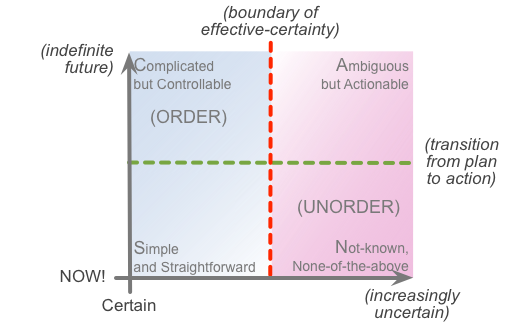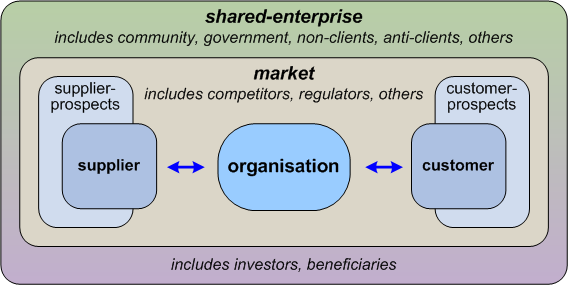Enterprise-architecture – too WEIRD, too WIRED?
Yeah: weird again – though this time it’s about a rather different kind of weirdness than those I’ve been exploring in recent posts.
The starting-point here is a recent Tweet by Sinan Si Alhir:
- @SAlhir: Why Americans Are the Weirdest People in the World http://t.co/eQFWbbBYRR
It points to a 2013 article by Ethan Watters – variously titled ‘We Aren’t The World’, or ‘Why Americans are the Weirdest People In The World’ – which in turn points to a now-classic 2009 paper by Henrich, Heine and Norenzayan, ‘The Weirdest People In The World?’. The theme of the paper was the anthropology of psychology-experiments: in particular, that something like 96% of all published psychology papers in English over the past fifty years or so had been based on studies of US university-students. The results of such studies were often assumed to applicable worldwide, as descriptions of generic human characteristics. The key point that the paper makes is that such assumptions are highly questionable, because US students are barely representative at all as a ‘generic’ sample of the overall human population – in fact are part of an outlier subgroup that could be summarised by the acronym ‘WEIRD’:
- Western
- Industrialised
- Educated
- Rich
- Democratic
As the paper shows, the US itself is something of an outlier relative to the rest of the WEIRD nations: way over at the far extreme ‘Individualist’ end of the Individualist<->Collective axis, for example. Hence US university-students, far from being representative of a ‘typical baseline’, are more like an outlier (student) of an outlier (US) of an outlier (WEIRD cultures) – or about as far from ‘typical’ as it’s possible to get.
The implication is that a lot of the assumptions on which current psychology are probably not valid outside of that very narrow range, and hence need some serious revision to make them more applicable outside of that very small subset of the WEIRD.
Which brings us – perhaps inevitably? – to enterprise-architecture.
It’s not hard to see that a very large amount of enterprise-architecture theory and practice has come out of the WEIRD population and context, and hence is likely to be similarly problematic when we try to apply its assumptions elsewhere or in other contexts. Yet it’s actually even more extreme than that, because most current enterprise-architecture is not only overly-WEIRD, it’s overly-WIRED, too. WIRED here is another acronym, for which we really ought to put each of the terms in quote-marks, to indicate that each is itself a special-case:
- ‘Western’
- ‘Information-oriented’
- ‘Rational’
- ‘Enterprise’
- ‘Digital’
In a bit more detail:
— ‘Western’: Although enterprise-architecture is nominally global, most of its core-worldview and core-paradigms are not only Western in the sense used in the WEIRD acronym, but from a specific subset of that – namely the business-culture of large US and/or UK-based consultancy-organisations. Ideas and concepts from other significantly-different nominally-Western cultures – France or Germany, for example, or ‘small-countries‘ such as Sweden, Denmark, the Netherlands, South Africa, Canada or Australia – seem to get little if any attention; ideas from non-‘Western’ cultures – such India, China, Islamic nations, Latin America, post-colonial Africa – are rarely if ever mentioned at all.
— ‘Information-oriented’: There’s a two-fold focus here: on industries that are themselves oriented primarily towards information, or ‘money as information’, such as banking, insurance, finance and tax; and/or towards the information-flows needed by managers. Even then, it’s still primarily about data-flows rather than information-flows – information as the business-use or meaning of data – with little to no grasp of business-information in turn used as business-knowledge. Other types of flows – particularly flows of physical assets, or interactions across human-relationship webs – barely get any mention at all.
(A perhaps more-accurate alternate for ‘Information-oriented’ would be ‘IT-obsessed’, but we come back to the latter in the ‘Digital’ element of the WIRED acronym.)
— ‘Rational’: The focus is nominally on reasoned-argument, ‘rationalisation’ and the like – but again, it actually represents a very small subset, way over on the far-left of the SCAN frame:
In effect, it’s a subset of rationality that focusses almost exclusively on control, certainty and ‘order’, with little if any real grasp of ‘unorder’ – coping with inherent-uncertainty, inherent-unpredictability. Almost all notations used in EA – such as Archimate, UML, or BMM (Business Motivation Model) – assume a strict binary-modality, that things are either associated or not-associated, with no other possibilities between those two options. Hence, for example, we often see reference-frameworks for BYOD (Bring Your Own Device) policies and the like that are unusable in practice, because they don’t acknowledge real-world variability – such as in the classic MoSCoW set, ‘Must-be’, ‘Should-be’, ‘Could-be’, ‘Won’t-be’.
— ‘Enterprise’: Again, a very specific subset of ‘enterprise’, namely large commercial or governmental organisations and/or consortia – in other words, the target-market for large-consultancies. In most cases, it’s an even smaller subset: ‘enterprise’ used as a synonym for ‘enterprise-scale IT’, the target-market for large IT-consultancies. Almost nothing else: there’s little to no mention of smaller-scale enterprises, or even of larger-scale ones – a nation or industry as a whole, for example.
And ‘enterprise’ is also used here as a synonym for ‘organisation’ – a tiny subset of the shared-enterprise or ‘ecosystem-with-purpose’ within which the organisation itself will operate:
Architecturally-speaking, the conflation of ‘the organisation’ as ‘the enterprise’ is not a good idea, as it often constrains the viewpoint of the architecture to ‘inside-in’ only – whereas for most real-world business-purposes we not only also need ‘inside-out’ viewpoints, but ‘outside-in’ and ‘outside-out’ viewpoints as well:
These misuses of the term ‘enterprise’ – with small subsets purporting to be the whole, as a ‘term-hijack’ – are probably the core reasons why enterprise-architecture still struggles to gain credibility and acceptance anywhere outside of a narrow subset of IT-specific business-domains.
— ‘Digital’: Most of what currently purports to be ‘enterprise-architecture’ is almost obsessively IT-centric, often to the exclusion of anything else at all. It interprets all business-possibility and business-change primarily or exclusively in terms of potential or actual roles for digital-processing in some form or other – not only ignoring or excluding all other forms of flows or processing, but almost all other types of technologies. For example, we’ll often see social-media discussed solely in terms of the underlying technologies – not the social-interactions that make it it ‘social’ in the first place. As I commented some while back, in response to someone who’d asserted that “By far the most significant trend in our era has been the emergence and evolution of information technology”:
No disagreement that [IT] is an important trend, yes. … However, it’s only one significant trend amongst many that may affect the enterprise: others that are at least equally significant include the impact of regulation and deregulation enabling key types of business-models, globalisation, the role of containerisation and other physical-transportation technologies, raising and lowering of tariff-barriers, the role of non-IT-managed ‘tribal knowledge’, nanotechnologies, 3D-printing technologies, patents and other ‘intellectual-property’ regimes, the impacts of organisational culture, jurisdictional clashes, the rise of the BRICS nations and the faltering of many ‘Western’ nations, the increasing role of China and others in Africa with regard to control of key mineral-commodities, the risks to global communications posed by rising levels of space-junk and suchlike, broad-scale political themes such as the Arab Spring, and, increasingly, the impacts of climate-change.
There are immensely complex architectural trade-offs here, immensely complex wicked-problems, of which only one strand is ‘digital-IT’; and likewise ‘Western’ relative to the rest of the world, ‘Information’ relative to everything else in context, ‘Rational’ in relation to other forms of sensemaking and decision-making, and ‘Enterprise’ in relation to the overall enterprise of the human world. WIRED is important, yes: yet it’s a larger picture – a much larger picture – that we need to work with in any real-world enterprise-architecture.
So if our architecture of, for and about the enterprise implicitly ignores everything other than ‘Western’, ‘information’, ‘rational’, ‘enterprise’ and ‘digital-IT’, we may well find our organisation suddenly struggling to survive, with no idea of what the heck happened nor any means to respond. Not a wise idea, perhaps?
Which is why we need an enterprise-architecture that’s necessarily broader than just WEIRD and WIRED.
Over to you for comment, perhaps?



@Tom, Excellent observation and for the most part I cannot agree more. As an EA researcher I always try to understand the motivation behind trends. Why is WIRED so prominent?
IMHO it is because we all follow the masses and we do not want to be seen as being different or being difficult.
Western – Maybe because the Western world dominates the in their use of the English language, economy and technology, or maybe not?
Information Oriented – Maybe because we all want to comply and ensure good quality products and services, which implies data is important to us to comply to our quality certifications, or maybe not?
Rational – Maybe because we cannot be seen as being irrational and not complying with the masses. Perhaps being irrational would be seen as uncertainty, disorder and being out of control, or maybe not?
Enterprise – Maybe because we want to feel like we have more control over our limited scope. That we want others around ourself to belief we can change the world and what we do is important to them, or maybe not?
Digital – Maybe because digital is what we know, and it is fundamentally logical. It excludes people and all other complexities. As we all know people can fundamentally increase the complexity of any system, maybe focusing on digital makes our lives less complex, or maybe not?
Not only should we try and understand the rationale behind WIRED but also what impact it might have on the future of enterprise architecture.
It’s where the money is.
len.
Broader as UPSET?
Unrestricted instead of Enterprise
Process instead of Information
Scientific instead of Rational
Electronic instead of Digital
Total instead of Western
Thanks,
AS